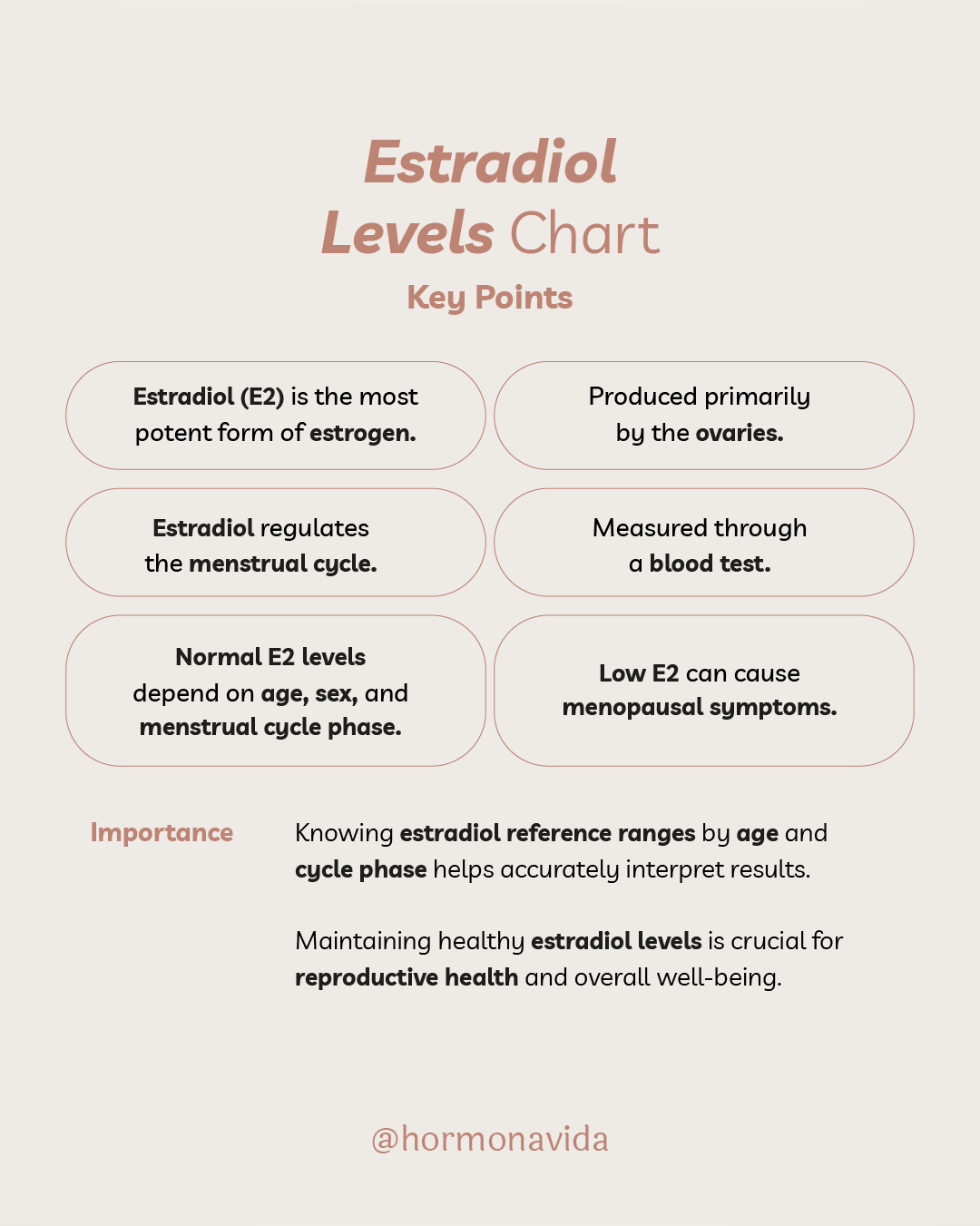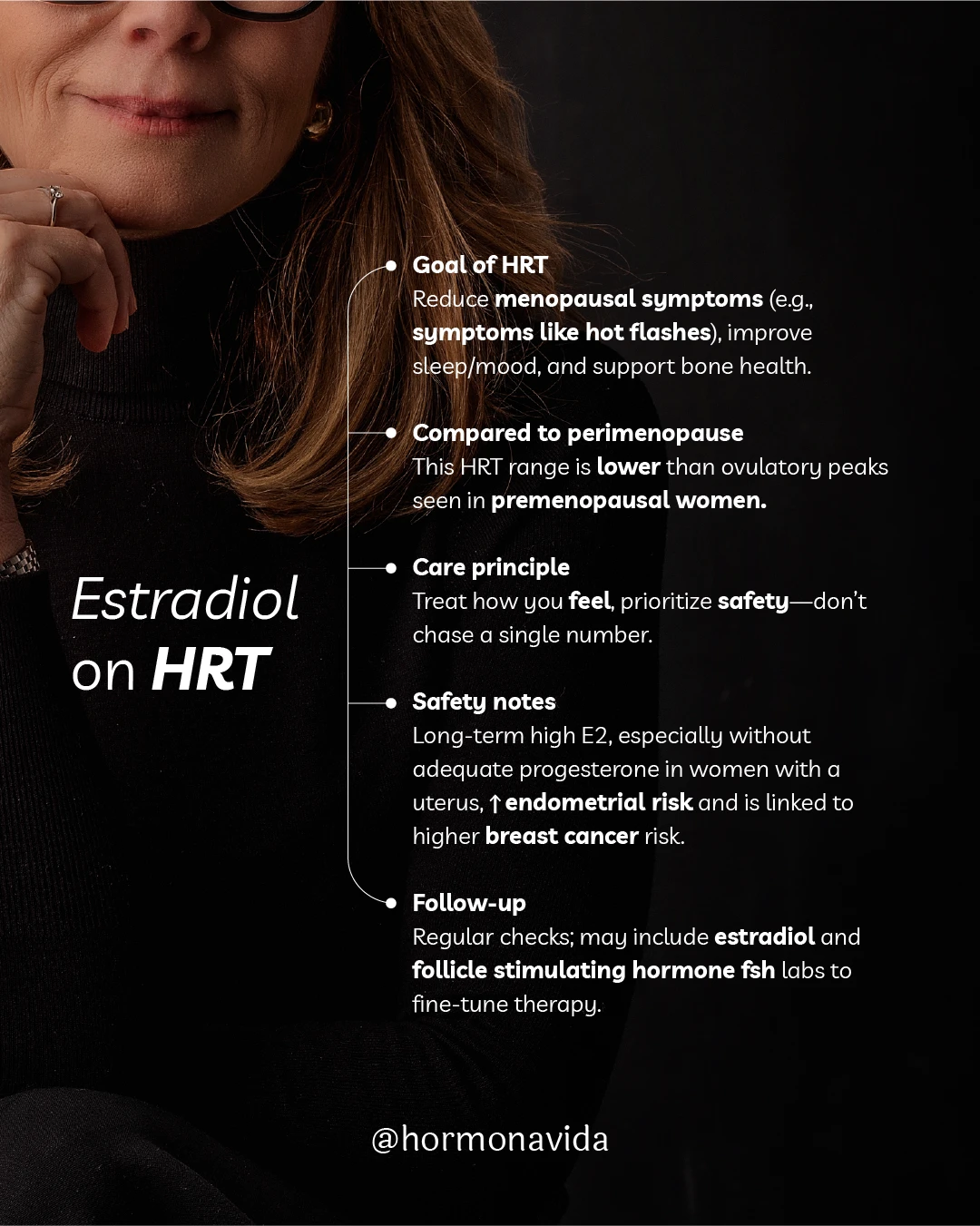Estradiol Levels Chart: Simple Guide to Healthy Ranges
Estradiol e2 is the most potent estrogen in women of reproductive age. The ovaries make most of it. A small amount also comes from the adrenal glands and body fat. Estradiol helps regulate the menstrual cycle and supports bones, skin, mood, sleep, sexual health, and heart wellness.
Clinicians check estradiol with a blood test. Labs report results in picograms per milliliter pg. Because estrogen levels change over the month, what is “normal” depends on age, sex, and menstrual cycle phase.
Keeping estradiol in a healthy range matters. If levels run low for your life stage, menopausal symptoms can show up. These include symptoms like hot flashes, night sweats, vaginal dryness, low mood, poor sleep, and bone loss.
If estradiol stays too high for a long time, risk may rise for estrogen-sensitive conditions, including breast cancer. Knowing typical reference ranges by age and cycle helps you and your clinician read your results with confidence. This guide explains normal estradiol by age, what to expect on HRT, common patch doses, and answers to top questions.

What Are Normal Estradiol Levels by Age
Estradiol shifts across life. It rises in puberty, cycles during the fertile years, wobbles in perimenopause, and settles low after menopause.
Childhood to Puberty
Before puberty, estradiol is very low (about 0–5 pg/mL). As puberty starts, ovarian activity ramps up and levels rise. This helps breast development and growth. Around the first periods, estradiol may reach ~20–30 pg/mL, even before regular ovulation begins.
Reproductive Age
In premenopausal women, estradiol follows a monthly rhythm tied to each menstrual cycle phase:
- Early follicular phase (right after your period starts): lower baseline, often around 30 pg ml to ~50 pg/mL.
- Mid–late follicular: levels rise as the dominant follicle matures.
- Pre-ovulatory peak: usually ~150–400 pg/mL. This surge triggers the pituitary to release luteinizing hormone lh, which causes ovulation.
- Luteal phase: after a brief dip, estradiol climbs to a moderate level (~70–150 pg/mL) and works with progesterone to support possible implantation.
- Late luteal → menstruation: estradiol returns to baseline (~20–50 pg/mL), and a new cycle starts.
Because of these shifts, reference ranges for premenopausal women are wide (about 30–400 pg/mL over a month). Many labs list phase-specific ranges (follicular, ovulation, luteal phase) to help you read a single result in context.
Pregnancy
During pregnancy, estrogen levels climb into the thousands of pg/mL. The placenta becomes a major source of estrogen and supports the uterus and the baby.
Perimenopause
In the 40s on average, cycles grow less regular and estradiol swings. Some months are high. Others are very low. There is no single “normal” number here.
Clinicians look at symptoms and follicle stimulating hormone fsh along with cycle patterns to read this stage. A higher fsh with irregular cycles points to a winding-down ovary.
Menopause and Beyond
Menopause means 12 months in a row with no period. Postmenopausal women usually have low estradiol (often <20–30 pg/mL). Many labs set postmenopause reference ranges as <30 pg/mL.
After menopause, the ovaries stop meaningful estrogen production. The body still makes a small amount through hormone conversion in fat and the adrenal glands, but much less than before.
This drop is why menopausal symptoms are common: symptoms like hot flashes, night sweats, vaginal dryness, mood shifts, sleep trouble, and bone loss. If a postmenopausal person uses estrogen therapy, her blood test will show higher estradiol from the medication, so we interpret results with that in mind.
Bottom line: estradiol rises in puberty, cycles during the fertile years, becomes erratic in perimenopause, and stays low after menopause. Always read a result in light of age, menstrual cycle phase, and symptoms.
What Should My Estradiol Level Be on HRT?
Many postmenopausal women use hormone replacement therapy (HRT) with estradiol to reduce menopausal symptoms and support bone health. There is no single “perfect” number for everyone.
Still, many clinicians use a practical window of about 50–100 pg/mL for people on systemic estradiol after menopause. This range is higher than untreated menopause (<30 pg/mL) but lower than the ovulatory peaks seen in premenopausal women.
Why this range? Mid-double-digit levels often ease symptoms like hot flashes, improve sleep and mood, and support bones without pushing estradiol too high.
If someone uses a transdermal patch and estradiol stays well under ~50 pg/mL while symptoms persist, a clinician may suspect under-dosing or poor absorption. In that case, the clinician may adjust the dose or how and where the patch is applied.
Care focuses on how you feel and on safety, not on chasing a single number. Long-term high estradiol, especially without enough progesterone in women with a uterus, can raise endometrial risk and is linked with higher breast cancer risk over time. So most teams use the lowest effective dose and check in regularly. Follow-up can include estradiol and follicle stimulating hormone fsh testing to fine-tune therapy.

Estradiol Patches Doses
Transdermal patches deliver estradiol through the skin. They avoid first-pass liver effects and keep levels steadier across the day. Boxes show the daily delivery rate. Common options include:
- 0.025 mg/day (25 micrograms/day)
- 0.0375 mg/day
- 0.05 mg/day (50 micrograms/day)
- 0.075 mg/day
- 0.1 mg/day (100 micrograms/day)
Some patches are once-weekly. Others are twice-weekly (changed every 3–4 days). To improve absorption, apply to clean, dry skin on the lower abdomen or upper buttocks, press edges well, avoid lotions on the site, and rotate locations.
Clinicians start low, often 0.025–0.05 mg/day. If menopausal symptoms continue, especially symptoms like hot flashes, the dose may rise to 0.075 or 0.1 mg/day.
Periodic blood test checks can confirm delivery. If readings stay very low and symptoms continue, we review dose, brand, site, and technique. Do not cut patches; that alters release. Use the right strength instead.
Why choose patches? They offer steady delivery, simple dose steps, and may have a more favorable effect on clotting factors and triglycerides than some oral forms. Many people get strong relief of vasomotor symptoms and bone protection with this route.
FAQ
What are normal estradiol levels in a woman?
It depends on life stage and menstrual cycle phase. In premenopausal women, estradiol runs about 30–400 pg/mL across a month: lowest in early follicular, highest just before ovulation, and moderate in the luteal phase. Postmenopausal women not on estrogen therapy are usually <30 pg/mL (often single digits to teens). Use phase-specific reference ranges and context.
What is considered a low estradiol level?
In adults, values that stay under ~20–30 pg/mL are generally “low.” That is expected in menopause. In younger people outside the very early follicular window, such low values can suggest low ovarian output. Low estradiol may link to menopausal symptoms such as symptoms like hot flashes, night sweats, vaginal dryness, mood change, and irregular cycles.
What estradiol level indicates menopause?
There is no single cutoff. After menopause, estradiol is commonly <30 pg/mL and fsh is higher. The clinical rule is 12 months without a period. Labs (estradiol plus follicle stimulating hormone fsh) support the diagnosis.
What should estradiol levels be on HRT?
There is no universal target. Many postmenopausal women feel well at ~50–100 pg/mL on systemic therapy. Clinicians treat symptoms first and use labs to guide adjustments, while avoiding unnecessary high exposure that might raise risks like breast cancer.
What estradiol patch doses are available?
Standard daily delivery rates are 0.025, 0.0375, 0.05, 0.075, and 0.1 mg/day. Depending on brand, you apply once or twice weekly. Dosing is individualized based on symptoms, tolerance, and occasional blood test checks of absorption.
Why do labs show “pg” and “pg/mL”?
Both refer to picograms per milliliter pg. Some reports shorten the unit to “pg,” but it means the same thing.
How does timing affect a test result?
Estradiol changes with menstrual cycle phase. A day-3 draw will look lower than a pre-ovulation draw. Try to test at the same point in your cycle if you want to compare results over time.
What if my lab’s numbers differ from a chart online?
Different labs use different methods, so reference ranges vary. Always compare your result to the range printed by your lab and consider age, cycle timing, and symptoms.
Do the adrenal glands matter after menopause?
Yes. After the ovaries slow down, the adrenal glands and fat tissue still make a small amount of estrogen by converting other hormones. It is modest, but it explains small differences among postmenopausal women.
Key Takeaways from the Estradiol Levels Chart
Estradiol e2 sits at the center of women’s hormone health. In puberty, levels rise from near zero to active ranges that shape development. Throughout reproductive age, estradiol follows a monthly rhythm: low in early follicular, climbing to trigger luteinizing hormone lh and ovulation, then settling into a moderate luteal phase level with progesterone. In pregnancy, estrogen levels soar as the placenta takes over.
In perimenopause, estradiol becomes unpredictable, so clinicians weigh symptoms, cycle history, and follicle stimulating hormone fsh more than a single E2 number. After menopause, postmenopausal women show persistently low estradiol (often <30 pg/mL). Only a small amount comes from fat and the adrenal glands. This change explains common menopausal symptoms, including symptoms like hot flashes, sleep trouble, vaginal dryness, and bone loss.
To read any estradiol blood test, use context. Consider age, menstrual cycle phase, and whether pregnancy or HRT is in play. Expect some variation in lab reference ranges. For those on HRT, many clinicians aim for a practical window, about 50–100 pg/mL, that balances symptom relief and safety.
Use the lowest effective dose. Re-check as needed. Transdermal patches provide steady delivery in clear steps (0.025–0.1 mg/day). Apply correctly and rotate sites. If symptoms continue, talk with your clinician about dose, brand, and timing of testing.
If you are tracking your estrogen levels, remember: one number is only part of the story. Pair results with how you feel and where you are in your cycle or life stage. With informed choices and care from a menopause-trained clinician, you can align estradiol, measured in picograms per milliliter pg, to support energy, mood, sleep, sexual comfort, bone strength, and long-term health at every stage.
References
- Everlywell. (2023, October 20). What Are Normal Estradiol Levels in Women? Everlywell Blog.
- MiraKind. (2023, August 16). What are “Normal” Estrogen Levels in Women?
- Belle Health. (n.d.). Normal Estradiol Levels by Age. BelleHealth Blog.
- Global Library of Women’s Medicine (GLOWM). (n.d.). Postmenopausal Hormone Therapy.
- Bryant, A. (2025, June 18). Estradiol Patch: Complete Guide to Dosage and Benefits. Rupa Health.
- WebMD. (n.d.). Normal Estrogen Levels in Women.
- Mindy Palmer. (2025, August 27). Estradiol Levels Chart: How to Tell If Your Estrogen is Normal. Inito Blog.




